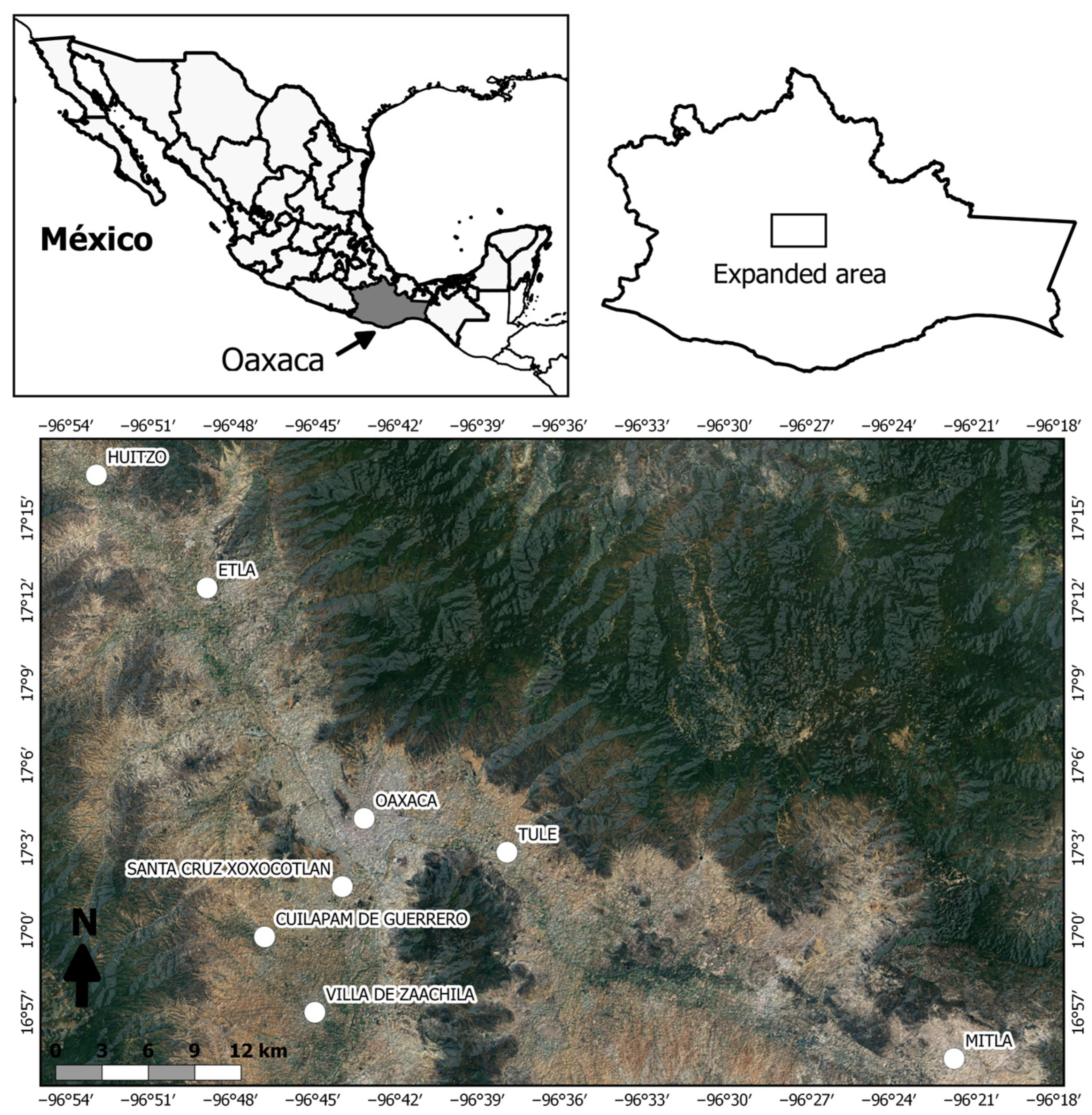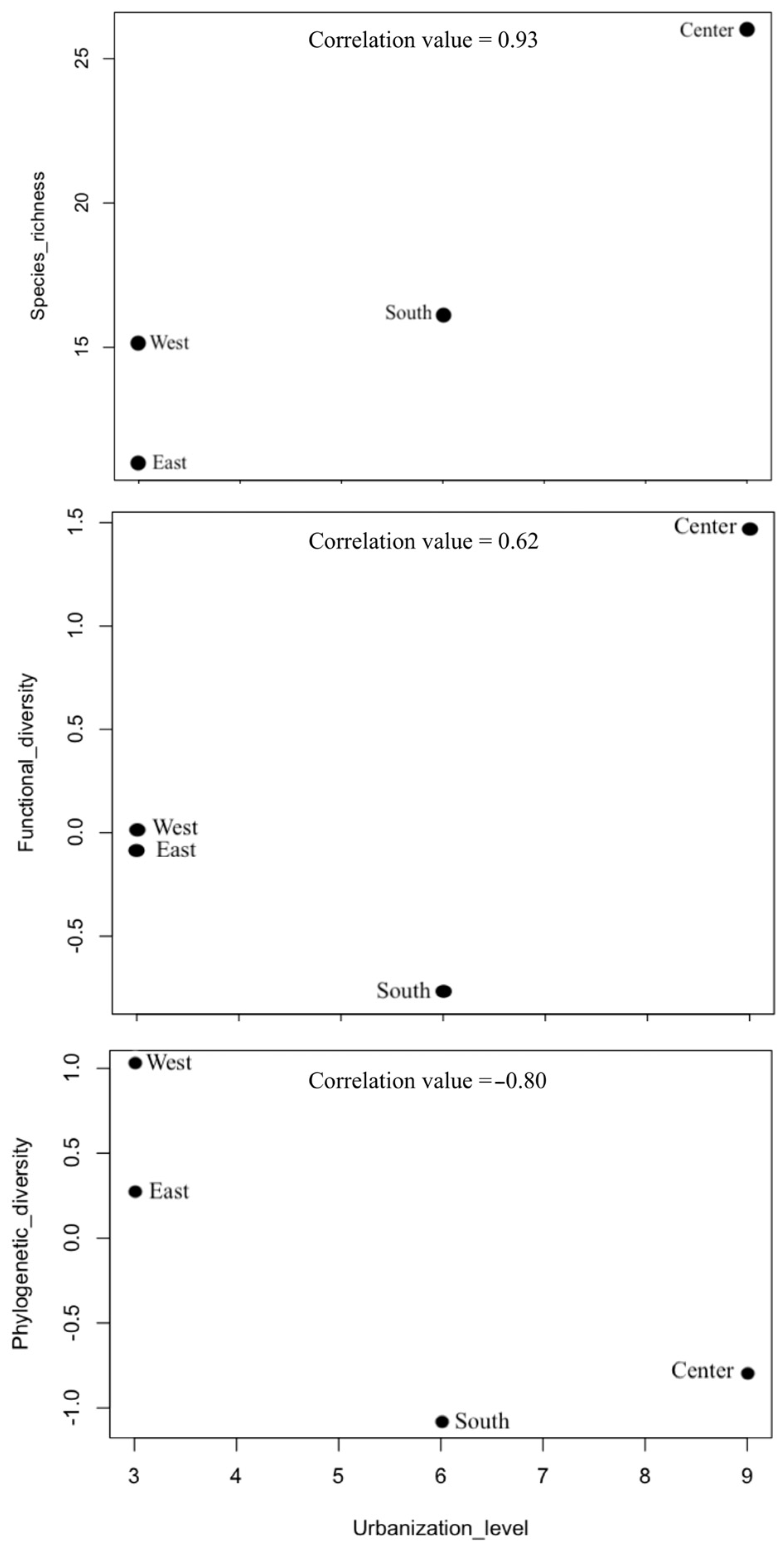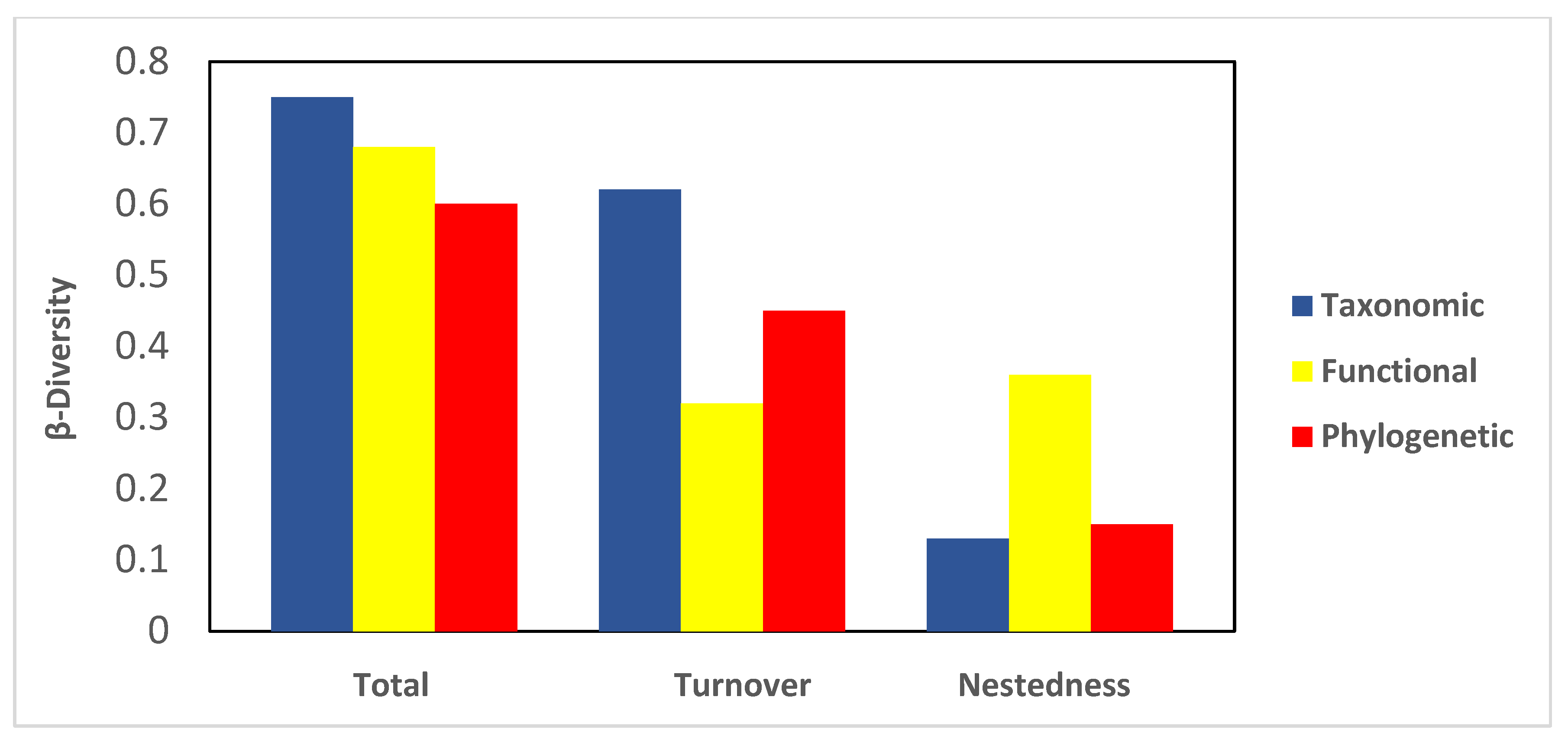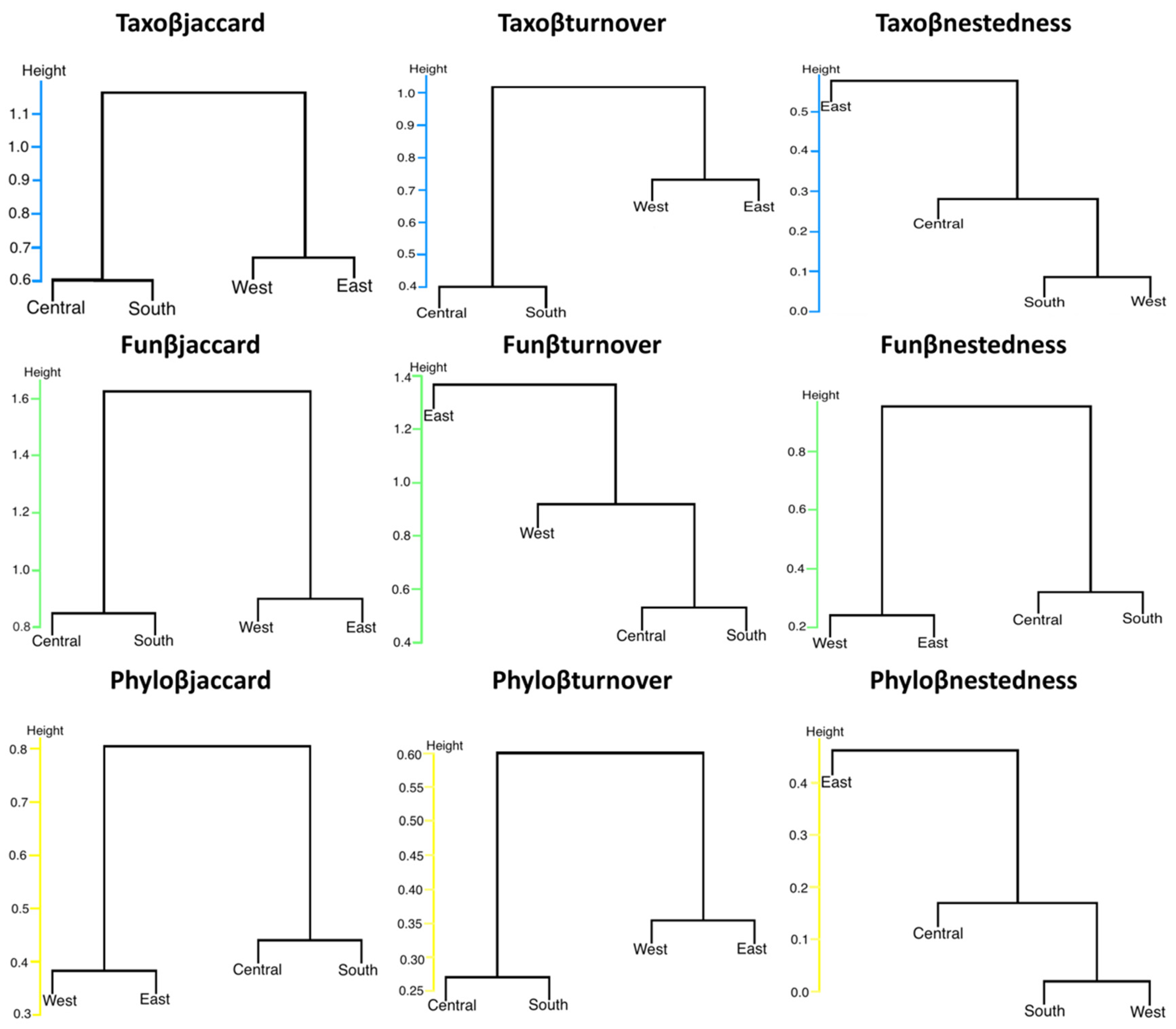Taxonomic, Functional, and Phylogenetic Diversity of Bats in Urban and Suburban Environments in Southern México
Abstract
1. Introduction
2. Materials and Methods
2.1. Study Area
2.2. Data Collection
2.3. Selection of Functional Traits
2.4. Calculation of α Taxonomic, Functional, and Phylogenetic Diversities
2.5. Urbanization vs. Taxonomic, Functional, and Phylogenetic Diversities
2.6. Calculating Taxonomic, Functional, and Phylogenetic β Diversities
3. Results
4. Discussion
5. Conclusions
Supplementary Materials
Author Contributions
Funding
Institutional Review Board Statement
Data Availability Statement
Acknowledgments
Conflicts of Interest
References
- Russo, D.; Ancillotto, L. Sensitivity of bats to urbanization: A review. Mammal. Biol. 2015, 80, 205–212. [Google Scholar] [CrossRef] [PubMed]
- Newbold, T.; Scharlemann, J.P.; Butchart, S.H.; Şekercioğlu, Ç.H.; Alkemade, R.; Booth, H.; Purves, D.W. Ecological traits affect the response of tropical forest bird species to land-use intensity. Proc. R. Soc. B Biol. Sci. 2013, 280, 2012–2131. [Google Scholar] [CrossRef] [PubMed]
- Sala, O.E.; Stuart Chapin, F.I.; Armesto, J.J.; Berlow, E.; Bloomfield, J.; Dirzo, R.; Huber-Sanwald, E.; Huenneke, L.F.; Jackson, R.B.; Kinzig, A.; et al. Global biodiversity scenarios for the year 2100. Science 2000, 287, 1770–1774. [Google Scholar] [CrossRef] [PubMed]
- Téllez-Hernández, E.; Domínguez-Vega, H.; Zuria, I.; Marín-Togo, M.C.; Gómez-Ortiz, Y. Functional and ecological diversity of urban birds: Conservation and redesign of biocultural landscapes. J. Nat. Conserv. 2023, 73, 126395. [Google Scholar] [CrossRef]
- Gutiérrez-Granados, G.; Rodríguez-Zúñiga, M.T. Bats as indicators of ecological resilience in a megacity. Urban Ecosyst. 2024, 27, 479–489. [Google Scholar] [CrossRef]
- Threlfall, C.G.; Law, B.; Banks, P.B. Sensitivity of insectivorous bats to urbanization: Implications for suburban conservation planning. Biol. Conserv. 2012, 146, 41–52. [Google Scholar] [CrossRef]
- Gorresen, P.M.; Willig, M.R.; Strauss, R.E. Multivariate analysis of scale dependent associations between bats and landscape structure. Ecol. Appl. 2005, 15, 2126–2136. [Google Scholar] [CrossRef]
- García-Morales, R.; Moreno, C.E.; Badano, E.I.; Zuria, I.; Galindo-González, J.; Rojas-Martínez, A.E.; Ávila-Gómez, E.S. Deforestation impacts on bat functional diversity in tropical landscapes. PLoS ONE 2016, 11, e0166765. [Google Scholar] [CrossRef]
- García-Luis, M.; Briones-Salas, M. Composición y actividad de la comunidad de murciélagos artropodívoros en parques eólicos del trópico mexicano. Rev. Mex. Biodiv. 2017, 88, 888–898. [Google Scholar] [CrossRef]
- Moreno, C.E.; Calderón-Patrón, J.M.; Arroyo-Rodríguez, V.; Barragán, F.; Escobar, F.; Gómez-Ortiz, Y.; Zuria, I. Measuring biodiversity in the Anthropocene: A simple guide to helpful methods. Biodivers. Conserv. 2017, 26, 2993–2998. [Google Scholar] [CrossRef]
- Moreno, C.E.; Calderón-Patrón, J.M.; Martín-Regalado, N.; Martínez-Falcón, A.P.; Ortega-Martínez, I.J.; Rios-Díaz, C.L.; Rosas, F. Measuring species diversity in the tropics: A review of methodological approaches and framework for future studies. Biotropica 2018, 50, 929–941. [Google Scholar] [CrossRef]
- Devictor, V.; Mouillot, D.; Meynard, C.; Jiguet, F.; Thuiller, W.; Mouquet, N. Spatial mismatch and congruence between taxonomic, phylogenetic and functional diversity: The need for integrative conservation strategies in a changing world. Ecol. Lett. 2010, 13, 1030–1040. [Google Scholar] [CrossRef] [PubMed]
- Lees, A.C.; Moura, N.G. Taxonomic, phylogenetic and functional diversity of an urban Amazonian avifauna. Urban Ecosyst. 2017, 20, 1019–1025. [Google Scholar] [CrossRef]
- Morelli, F.; Benedetti, Y.; Su, T.; Zhou, B.; Moravec, D.; Šímová, P.; Liang, W. Taxonomic diversity, functional diversity and evolutionary uniqueness in bird communities of Beijing’s urban parks: Effects of land use and vegetation structure. Urban For. Urban Green. 2017, 23, 84–92. [Google Scholar] [CrossRef]
- Castillo-Figueroa, D.; Pérez-Torres, J. On the development of a trait-based approach for studying Neotropical bats. Pap. Avulsos Zool. 2021, 61, e20216124. [Google Scholar] [CrossRef]
- Cisneros, L.; Fagan, M.E.; Willig, M.R. Effects of human-modified landscapes on taxonomic, functional and phylogenetic dimensions of bats biodiversity. Divers. Distrib. 2015, 21, 523–533. [Google Scholar] [CrossRef]
- Mouchet, M.A.; Villéger, S.; Mason, N.W.; Mouillot, D. Functional diversity measures: An overview of their redundancy and their ability to discriminate community assembly rules. Funct. Ecol. 2010, 24, 867–876. [Google Scholar] [CrossRef]
- Petchey, O.L.; Gaston, K.L. Functional diversity: Back to basics and looking forward. Ecol. Lett. 2006, 9, 741–758. [Google Scholar] [CrossRef]
- Laity, T.; Laffan, S.W.; González-Orozco, C.E.; Faith, D.P.; Rosauer, D.F.; Byrne, M.; Miller, J.T.; Crayn, D.; Costion, C.; Moritz, C.C.; et al. Phylodiversity to inform conservation policy: An Australian example. Sci. Total Environ. 2015, 534, 131–143. [Google Scholar] [CrossRef]
- Tucker, C.M.; Cadotte, M.W.; Carvalho, S.B.; Davies, T.J.; Ferrier, S.; Fritz, S.A.; Mazel, F. A guide to phylogenetic metrics for conservation, community ecology and macroecology. Biol. Rev. 2017, 92, 698–715. [Google Scholar] [CrossRef]
- Ortiz, P.M.A.; Hernández, J.R.S.; Figueroa Mah-Eng, J.M. Reconocimiento fisiográfico y geomorfológico. In Biodiversidad de Oaxaca; García-Mendoza, A.J., Ordónez, M.J., Briones-Salas, M., Eds.; Instituto de Biología, Universidad Nacional Autónoma de México-Fondo Oaxaqueño para la Conservación de la Naturaleza-World Wildlife Found: Oaxaca, Mexico, 2004; pp. 43–45. [Google Scholar]
- Torres, C.T. Tipos de vegetación. In Biodiversidad de Oaxaca; García-Mendoza, A.J., Ordónez, M.J., Briones-Salas, M., Eds.; Instituto de Biología, Universidad Nacional Autónoma de México-Fondo Oaxaqueño para la Conservación de la Naturaleza-World Wildlife Found: Oaxaca, Mexico, 2004; pp. 105–117. [Google Scholar]
- Trejo, I. Clima. In Biodiversidad de Oaxaca; García-Mendoza, A.J., Ordónez, M.J., Briones-Salas, M., Eds.; Instituto de Biología, Universidad Nacional Autónoma de México-Fondo Oaxaqueño para la Conservación de la Naturaleza-World Wildlife Found: Oaxaca, Mexico, 2004; pp. 67–85. [Google Scholar]
- INEGI (Instituto Nacional de Estadística y Geografía). Censo Nacional de Vivienda; Instituto Nacional de Estadística y Geografía: San Luis Potosí, México, 2010. [Google Scholar]
- INEGI (Instituto Nacional de Estadística y Geografía). Uso de Suelo y Vegetación serie V, Escala 1:250,000; Instituto Nacional de Estadística y Geografía: San Luis Potosí, México, 2013. [Google Scholar]
- Vargas-Contreras, J.A.; Escalona-Segura, G.; Cú-Vizcarra, J.D.; Arroyo-Cabrales, J.; Medellín, R.A. Estructura y Diversidad de los Ensambles de Murciélagos en el Centro y sur de Campeche, México; Avances en el estudio de los mamíferos de México: Ciudad de México, México, 2008; pp. 551–577. [Google Scholar]
- Medellín, R.A.; Arita, H.T.; Sánchez, Ó. Identificación de los Murciélagos de México: Clave de Campo; Instituto de Ecología, UNAM: Ciudad de México, México, 2008; pp. 28–63. [Google Scholar]
- Ramírez-Pulido, J.; González-Ruiz, N.; Gardner, A.L.; Arroyo-Cabrales, J. List of Recent Land Mammals of Mexico; Museum of Texas Tech University: Lubbock, TX, USA, 2014; pp. 6–16. [Google Scholar]
- Ortega, J.; MacSwiney, M.C.; Zamora, V. Compendio de los Llamados de Ecolocalización de los Murciélagos Insectívoros Mexicanos; Asociación Mexicana de Mastozoología, A.C. y CONABIO: Ciudad de México, México, 2022; pp. 24–217. [Google Scholar]
- McGill, B.J.; Enquist, B.J.; Weiher, E.; Westoby, M. Rebuilding community ecology from functional traits. Trends Ecol. Evol. 2006, 21, 178–185. [Google Scholar] [CrossRef] [PubMed]
- Villéger, S.; Mason, N.W.H.; Mouillot, D. New multidimensional functional diversity indices for a multifaceted framework in functional ecology. Ecology 2008, 89, 2290–2301. [Google Scholar] [CrossRef] [PubMed]
- Flynn, D.F.; Gogol-Prokurat, M.; Nogeire, T.; Molinari, N.; Richers, B.T.; Lin, B.B.; DeClerck, F. Loss of functional diversity under land use intensification across multiple taxa. Ecol. Lett. 2009, 12, 22–33. [Google Scholar] [CrossRef] [PubMed]
- Safi, K.; Cianciaruso, M.V.; Loyola, R.D.; Brito, D.; Armour-Marshall, K.; Diniz-Filho, J.A.F. Understanding global patterns of mammalian functional and phylogenetic diversity. Philos. Trans. R. Soc. Lond. B Biol. Sci. 2011, 366, 2536–2544. [Google Scholar] [CrossRef]
- Martín-Regalado, C.N.; Briones-Salas, M. Rasgos funcionales para mamíferos terrestres del sur de México. Caldasia 2024, 46, 1–29. [Google Scholar]
- Petchey, O.L.; Gaston, K.J. Functional diversity (FD), species richness and community composition. Ecol. Lett. 2002, 5, 402–411. [Google Scholar] [CrossRef]
- Gotelli, N.J. Null model analysis of species co-occurrence patterns. Ecology 2000, 81, 2606–2621. [Google Scholar] [CrossRef]
- Laliberté, E.; Legendre, P.; Shipley, B.; Laliberté, M.E. Measuring functional diversity from multiple traits, and other tools for functional ecology. In R Package FD; R Core Team: Vienna, Austria, 2014. [Google Scholar]
- Oksanen, J. Vegan: Community Ecology Package. 2010. Available online: http://vegan.r-forge.r-project.org/ (accessed on 10 June 2024).
- Faith, D.P. Conservation evaluation and phylogenetic diversity. Biol. Conserv. 1992, 61, 1–10. [Google Scholar] [CrossRef]
- Faith, D.P. The PD phylogenetic diversity framework: Linking evolutionary history to feature diversity for biodiversity conservation. In Biodiversity Conservation and Phylogenetic Systematics; Springer: Berlin/Heidelberg, Germany, 2016; pp. 39–56. [Google Scholar]
- Upham, N.S.; Esselstyn, J.A.; Jetz, W. Inferring the mammal tree: Species- level sets of phylogenies for questions in ecology, evolution, and conservation. PLoS Biol. 2019, 17, e3000494. [Google Scholar] [CrossRef]
- Kembel, S.W.; Cowan, P.D.; Helmus, M.R.; Cornwell, W.K.; Morlon, H.; Ackerly, D.D.; Blomberg, S.P.; Webb, C.O. Picante: R tools for integrating phylogenies and ecology. Bioinformatics 2010, 26, 1463–1464. [Google Scholar] [CrossRef]
- Baselga, A.D.; Orme, S.; Villeger, J.; De Bortoli, F. Leprieur. Betapart: Partitioning Beta Diversity into Turnover and Nestedness Components. R Package Version 1.5.1. Available online: https://CRAN.R-project.org/package=betapart. (accessed on 19 April 2023).
- Ricotta, C.; Burrascano, S. Beta diversity for functional ecology. Preslia 2008, 80, 61–71. [Google Scholar]
- Graham, C.H.; Fine, P.V.A. Phylogenetic beta diversity: Linking ecological and evolutionary processes across space in time. Ecol. Lett. 2008, 11, 1265–1277. [Google Scholar] [CrossRef] [PubMed]
- Espinal-Palomino, R.; Ibarra-Cerdeña, C.N. Siluetas en el cielo: Murciélagos en mi ciudad. Therya Ixmana 2022, 1, 42–44. [Google Scholar] [CrossRef]
- Pierson, E.D. Tall trees, deep holes, and scarred landscapes: Conservation biology of North American bats. In Bat Biology and Conservation; Kunz, T.H., Racey, P.A., Eds.; Smithsonian Institution Press: Washington, DC, USA, 1998; pp. 309–325. [Google Scholar]
- Palheta, L.R.; Urbieta, G.L.; Brasil, L.S.; Dias-Silva, K.; Da Silva, J.B.; Graciolli, G.; Aguilar, L.M.S.; Vieira, T.B. The effect of urbanization on bats and communities of bat flies (Diptera: Nycteribiidae and Streblidae) in the Amazon, northern Brazil. Acta Chiropt. 2020, 22, 403–416. [Google Scholar] [CrossRef]
- Briones-Salas, M.; Cortés-Marcial, M.; Lavariega, M.C. Diversidad y distribución geográfica de los mamíferos terrestres del estado de Oaxaca, México. Rev. Mex. Biodiv. 2015, 8, 685–710. [Google Scholar] [CrossRef]
- Gurrusquieta-Navarro, M.C. Dieta de Murciélagos Frugívoros en la Zona Urbana de Cuernavaca Morelos. Bachelor Thesis, Universidad Autónoma de Morelos, Morelos, Mexico, 2015. [Google Scholar]
- Ferreyra-García, D.; Saldaña-Vázquez, R.A.; Mendoza, E. Macrotus waterhousii en Morelia, México. Boletín Red Latinoam. Para Conserv. Murciélagos 2017, 8, 20–23. [Google Scholar]
- Jung, K.; Kalko, E.K. Adaptability and vulnerability of high flying Neotropical aerial insectivorous bats to urbanization. Divers. Distrib. 2011, 17, 262–274. [Google Scholar] [CrossRef]
- Starik, N.; Gygax, L.; Göttert, T. Unexpected bat community changes along an urban-rural gradient in the Berlin-Brandenburg metropolitan area. Sci. Rep. 2024, 14, 10552. [Google Scholar] [CrossRef]
- Saldaña-Vázquez, R.A.; Ferreyra-García, D.; Vázquez-Domínguez, G. ¿Murciélagos en mi ciudad? Consejos y reflexiones para convivir con ellos. Digit. Cienc.@ UAQRO 2019, 12, 28–32. [Google Scholar]
- Rodríguez-Aguilar, G.; Orozco-Lugo, C.L.; Vleut, I.; Vazquez, L.B. Influence of urbanization on the occurrence and activity of aerial insectivorous bats. Urban Ecosyst. 2017, 20, 477–488. [Google Scholar] [CrossRef]
- Fenton, M.B.; Bogdanowicz, W. Relationships between external morphology and foraging behaviour: Bats in the genus Myotis. Can. J. Zool. 2002, 80, 1004–1013. [Google Scholar] [CrossRef]
- Kunz, T.H.; Braun de Torrez, E.; Bauer, D.; Lobova, T.; Fleming, T.H. Ecosystem services provided by bats. Ann. N. Y. Acad. Sci. 2011, 1223, 1–38. [Google Scholar] [CrossRef]
- Tsianou, M.A.; Kallimanis, A.S. Different species traits produce diverse spatial functional diversity patterns of amphibians. Biodivers. Conserv. 2016, 25, 117–132. [Google Scholar] [CrossRef]
- Gordon, R.; Ivens, S.; Ammerman, L.; Fenton, M.; Littlefair, J.; Ratcliffe, J.; Clare, E. Molecular diet analysis finds an insectivorous desert bat community dominated by resource sharing despite diverse echolocation and foraging strategies. Ecol. Evol. 2019, 9, 3117–3129. [Google Scholar] [CrossRef]
- Nee, S.; May, R.M. Extinction and the Loss of Evolutionary History. Science 1997, 278, 692–694. [Google Scholar] [CrossRef]
- Purvis, A.; Agapow, P.M.; Gittleman, J.L.; Mace, G.M. Nonrandom extinction and the loss of evolutionary history. Science 2000, 288, 328–330. [Google Scholar] [CrossRef]
- Huang, S.; Davies, T.J.; Gittleman, J.L. How global extinctions impact regional biodiversity in mammals. Biol. Lett. 2011, 8, 222–225. [Google Scholar] [CrossRef] [PubMed]
- McKinney, M. Urbanization as a major cause of biotic homogenization. Biol. Conserv. 2006, 127, 247–260. [Google Scholar] [CrossRef]
- García-Luis, M.; Briones-Salas, M.; Lavariega, M.C. Bat species richness in the region of the Central Valleys of Oaxaca, México. Arxius Misc. Zool. 2019, 17, 1–11. [Google Scholar] [CrossRef]
- Vissoto, M.; Schneiberg, I.; Varassin, I.G.; de Araujo, A.C.; Maruyama, P.K.; Vizentin-Bugoni, J. Frugivory and seed dispersal in tropical urban areas: A review. In Ecology of Tropical Cities: Natural and Social Sciencies; Angeoletto, F., Tryjanowski, P., Fellowes, M., Eds.; Springer Nature: Berlin/Heidelberg, Germany, 2023; pp. 1–33. [Google Scholar]
- Poma, M.G.G.; Poma, F.C.G. Métodos de exclusión de murciélagos hematófagos en edificaciones humanas. Boletín Malariol. Salud Ambient. 2022, 62, 1363–1370. [Google Scholar] [CrossRef]
- Cerón-Hernández, J.A.; Serna-Lagunes, R.; Torres-Cantú, G.B.; Llarena-Hernández, C.R.; Mora-Collado, N.; García-Martínez, M.Á. Diversidad, tipos de dieta de murciélagos y su respuesta a bordes de bosque mesófilo de montaña, Veracruz, México. Ecosis. Recur. Agropec. 2022, 9, 1–13. [Google Scholar] [CrossRef]
- Tuttle, M.D.; Moreno, A. Murciélagos Cavernícolas del Norte de México. Su Importancia y Problemas de Conservación; Bat Conservation International Inc.: Austin, TX, USA, 2005. [Google Scholar]
- Calderón-Patrón, J.; Briones-Salas, M.; Moreno, C.E. Diversidad de murciélagos en cuatro tipos de bosque de la Sierra Norte de Oaxaca, México. Therya 2013, 4, 121–137. [Google Scholar] [CrossRef]
- Baselga, A. Partitioning the turnover and nestedness components of beta diversity. Glob. Ecol. Biogeogr. 2010, 19, 134–143. [Google Scholar] [CrossRef]
- Calderón-Patrón, J.M.; Peña-Joya, K.E.; Téllez-López, J.; Canales-Gómez, E.P. Dissimilarity among Species and Higher Taxa of Amphibians in a Hotspot of Biodiversity and Endemism in the Neotropics. Diversity 2024, 16, 224. [Google Scholar] [CrossRef]
- Zeng, C.; Li, W.; Ding, P.; Peng, Y.; Wu, L.; Si, X. A landscape level analysis of bird taxonomic, functional and phylogenetic β-diversity in habitat island systems. J. Biogeogr. 2022, 49, 1162–1175. [Google Scholar] [CrossRef]
- Carvalho, W.D.; Fluck, I.E.; de Castro, I.J.; Hilário, R.R.; Martins, A.C.M.; de Toledo, J.J.; Bobrowiec, P.E. Elevation drives taxonomic, functional and phylogenetic β-diversity of phyllostomid bats in the Amazon biome. J. Biogeogr. 2023, 50, 70–85. [Google Scholar] [CrossRef]
- Calderón-Patrón, J.M.; Moreno, C.E.; Pineda-López, R.; Sánchez-Rojas, G.; Zuria, I. Vertebrate dissimilarity due to turnover and richness differences in a highly beta-diverse region: The role of spatial grain size, dispersal ability and distance. PLoS ONE 2013, 8, e82905. [Google Scholar] [CrossRef]
- Cornejo-Latorre, C.; Moreno, C.E.; Martín-Regalado, C.N.; Briones-Salas, M. Taxonomic and phylogenetic beta diversity of cricetid rodents in Oaxaca, southern Mexico. J. Mammal. 2020, 101, 1451–1462. [Google Scholar] [CrossRef]
- Gutiérrez-Granados, G. Murciélagos viajeros: El misterio de las migraciones nocturnas. Therya Ixmana 2023, 2, 62–63. [Google Scholar] [CrossRef]
- Godoy, O.; Kraft, N.J.; Levine, J.M. Phylogenetic relatedness and the determinants of competitive outcomes. Ecol. Lett. 2014, 17, 836–844. [Google Scholar] [CrossRef]
- Darwin, C. The Origin of Species, 1859–1959. Bios 1959, 30, 67–72. [Google Scholar]
- Møller, A.P.; Díaz, M. Avian preference for close proximity to human habitation and its ecological consequences. Curr. Zool. 2018, 64, 623–630. [Google Scholar] [CrossRef] [PubMed]




| Site | Asphalt-Covered Areas | Green Areas | Population | Households | Urbanization | |
|---|---|---|---|---|---|---|
| Level | Value | |||||
| Central | 70% | 30% | 371,397 | 87,768 | Urban site | 9 |
| South | 51% | 49% | 73,346 | 16,347 | Semi-urban site | 6 |
| East | 28% | 72% | 22,526 | 5113 | Rural site | 3 |
| West | 12% | 88% | 11,203 | 3477 | Rural site | 3 |
| Traits | Value/Category (Units) | Variable Type |
|---|---|---|
| Morphological traits | ||
| 1. Total length | mean (mm) | continuous |
| 2. Tail length | mean (mm) | continuous |
| 3. Hind foot length | mean (mm) | continuous |
| 4. Ear length | mean (mm) | continuous |
| 5. Forearm length | mean (mm) | continuous |
| 6. Body mass | mean (g) | continuous |
| Reproductive traits | ||
| 7. Number of offspring per litter | average | ordinal |
| Ecological traits | ||
| 8. Diet | arthropodivore | categorical |
| frugivore | categorical | |
| sanguinivore | categorical | |
| nectarivore.pollinivore | categorical | |
| nectarivore.pollinivore.insectivore | categorical | |
| 9. Wing bags | absent | categorical |
| present | categorical | |
| 10. Nasal leaf | absent | categorical |
| rudimentary | categorical | |
| 11. Uropatagium | absent | categorical |
| complete | categorical | |
| conspicuous | categorical | |
| reduced | categorical | |
| 12. Tail | absent | categorical |
| embedded | categorical | |
| free | categorical | |
| Systematic List | Site | |||
|---|---|---|---|---|
| Central | South | East | West | |
| Family Emballonuridae | ||||
| Balantiopteryx plicata Peters, 1867 | 1 | 1 | 0 | 0 |
| Family Molossidae | ||||
| Molossus molossus (Pallas, 1766) | 0 | 1 | 0 | 0 |
| Molossus rufus E. Geoffroy Saint-Hilaire, 1805 | 1 | 1 | 0 | 0 |
| Nyctinomops laticaudatus (E. Geoffroy Saint-Hilaire, 1805) | 0 | 1 | 0 | 0 |
| Promops centralis Thomas, 1915 | 1 | 0 | 1 | 0 |
| Tadarida brasiliensis (I. Geoffroy Saint-Hilaire, 1824) | 1 | 1 | 1 | 1 |
| Family Mormoopidae | ||||
| Mormoops megalophylla (Peters, 1864) | 1 | 0 | 0 | 0 |
| Pteronotus davyi Gray, 1838 | 0 | 1 | 0 | 0 |
| Pteronotus parnellii (Gray, 1843) | 0 | 0 | 0 | 1 |
| Family Phyllostomidae | ||||
| Desmodus rotundus (E. Geoffroy Saint-Hilaire, 1810) | 1 | 1 | 1 | 1 |
| Anoura geoffroyi Gray, 1838 | 1 | 1 | 0 | 1 |
| Choeronycteris mexicana Tschudi, 1844 | 1 | 0 | 1 | 1 |
| Hylonycteris underwoodi Thomas, 1903 | 0 | 1 | 0 | 0 |
| Glossophaga soricina (Pallas, 1766) | 1 | 0 | 1 | 1 |
| Leptonycteris nivalis (de Saussure, 1860) | 0 | 0 | 0 | 1 |
| Leptonycteris yerbabuenae Martínez & Villa, 1940 | 1 | 0 | 1 | 1 |
| Artibeus jamaicensis Leach, 1821 | 1 | 1 | 0 | 1 |
| Artibeus lituratus (Olfers, 1818) | 1 | 1 | 1 | 0 |
| Dermanura azteca (Andersen, 1906) | 1 | 0 | 0 | 0 |
| Sturnira hondurensis Goodwin, 1940 | 1 | 1 | 1 | 1 |
| Sturnira parvidens Goldman, 1917 | 1 | 1 | 1 | 1 |
| Family Vespertilionidae | ||||
| Aeroestes cinereus (Palisot de Beauvois, 1796) | 1 | 0 | 0 | 1 |
| Myotis californicus (Audubon & Bachman, 1842) | 1 | 0 | 1 | 1 |
| Myotis fortidens Miller & G. M. Allen, 1928 MX | 1 | 0 | 0 | 0 |
| Myotis keaysi J. A. Allen, 1914 | 1 | 0 | 0 | 0 |
| Myotis thysanodes Miller, 1897 | 1 | 0 | 0 | 0 |
| Myotis velifer (J. A. Allen, 1890) | 1 | 0 | 0 | 0 |
| Eptesicus fuscus (Palisot de Beauvois, 1796) | 1 | 0 | 0 | 1 |
| Lasiurus frantzii (Lesson, 1826) | 1 | 1 | 0 | 0 |
| Dasypterus ega (Gervais, 1856) | 1 | 1 | 0 | 0 |
| Dasypterus intermedius H. Allen, 1862 | 1 | 1 | 0 | 0 |
| Rhogeessa gracilis (Miller, 1897) MX | 0 | 0 | 0 | 1 |
| Corynorhinus townsendii (Cooper, 1837) | 1 | 0 | 1 | 0 |
| Total | 26 | 16 | 11 | 15 |
Disclaimer/Publisher’s Note: The statements, opinions and data contained in all publications are solely those of the individual author(s) and contributor(s) and not of MDPI and/or the editor(s). MDPI and/or the editor(s) disclaim responsibility for any injury to people or property resulting from any ideas, methods, instructions or products referred to in the content. |
© 2024 by the authors. Licensee MDPI, Basel, Switzerland. This article is an open access article distributed under the terms and conditions of the Creative Commons Attribution (CC BY) license (https://creativecommons.org/licenses/by/4.0/).
Share and Cite
Briones-Salas, M.; Medina-Cruz, G.E.; Martin-Regalado, C.N. Taxonomic, Functional, and Phylogenetic Diversity of Bats in Urban and Suburban Environments in Southern México. Diversity 2024, 16, 527. https://doi.org/10.3390/d16090527
Briones-Salas M, Medina-Cruz GE, Martin-Regalado CN. Taxonomic, Functional, and Phylogenetic Diversity of Bats in Urban and Suburban Environments in Southern México. Diversity. 2024; 16(9):527. https://doi.org/10.3390/d16090527
Chicago/Turabian StyleBriones-Salas, Miguel, Gabriela E. Medina-Cruz, and Cintia Natalia Martin-Regalado. 2024. "Taxonomic, Functional, and Phylogenetic Diversity of Bats in Urban and Suburban Environments in Southern México" Diversity 16, no. 9: 527. https://doi.org/10.3390/d16090527
APA StyleBriones-Salas, M., Medina-Cruz, G. E., & Martin-Regalado, C. N. (2024). Taxonomic, Functional, and Phylogenetic Diversity of Bats in Urban and Suburban Environments in Southern México. Diversity, 16(9), 527. https://doi.org/10.3390/d16090527






